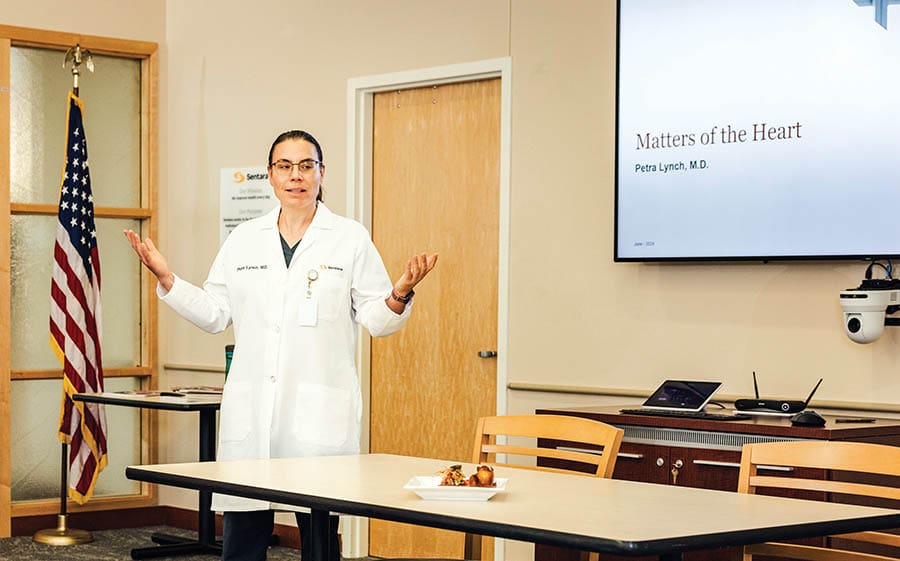Local specialists reach out to protect expectant and new mothers while creating awareness about hearth health and pregnancy risks
By Kristen De Deyn Kirk
Cardiologist Petra Lynch, a member of the American Heart Association Hampton Roads Go Red for Women executive leadership team, summarizes her work with a surprising sentence:
“I run the clinic of the unloved patient.”
As one of the founders of the Sentara-EVMS Cardio-Obstetrics Center, Lynch advocates for patients other physicians might avoid. When she started in cardiology, Lynch observed certain patients intimidating some of her colleagues. They’d see a pregnant woman on their list, review her history and fret.
She’d hear them say, “I don’t know what to do.” Lynch embraces challenges others decline.
“I read up, I get educated and submerge myself in what we are uncomfortable with,” Lynch says. “That’s how I got into cardio OB (obstetrics).”
Shortly after arriving in Coastal Virginia from Alabama two years ago, she spoke with a Sentara Healthcare administrator.
“I told her how bad it was that there was no ‘cardio-OB’,” Lynch says, referring to specialists advising pregnant women with heart conditions. The administrator told Lynch: “Let me fix that.”
The Sentara-EVMS Cardio-Obstetrics Center was born. It’s not an actual place. There aren’t any walls or rooms, Lynch explains, but instead physicians and other medical experts talking on the phone weekly.
Working with the team, including co-founder obstetrician gynecologist Gloria Too and obstetrician gynecologist Lindsay Robbins, Lynch establishes treatment plans and tracks patients’ progress. Some of the women are pregnant or thinking of getting pregnant. Others have recently delivered their babies. All have a risk of heart problems.
Heartache After Childbirth
Cecily Foster of Virginia Beach felt chest pain three days after leaving the hospital with her newborn daughter. Nothing bad. Maybe just her breast milk was coming in, she reasoned to herself.
Foster wasn’t a new mom. She had a son. She knew what to expect postpartum. But something about the lingering pressure in her chest made her call her doctor’s office. The nurse she spoke with ordered her to an emergency room.
“I had no idea why,” Foster recalls. “When I went, they did some testing, and that’s when they diagnosed me with postpartum cardiomyopathy.”
Foster works in healthcare so she understood the term—which means heart failure occurring after giving birth—but she was confused: She had only experienced a bit of pain. In retrospect, though, she should have been informed earlier of the possibility of her heart being in distress.
Near the end of her pregnancy, Foster was exhausted. She retained fluid. Her legs swelled. Her feet grew so large that she couldn’t wear shoes. A doctor detailed serious concerns when Foster was 36 weeks pregnant: Her placenta wasn’t growing; her baby wasn’t growing; and she had preeclampsia, pregnancy-induced high blood pressure. She needed to deliver her baby right away.
No one had talked about her heart.
After her diagnosis of postpartum cardiomyopathy and a week’s stay in the hospital, Foster headed home. Fear flooded her: Her only symptom was tiredness, caused by a low ejection fraction, a low volume of blood pumping out of her heart when it contracted.
Hers was measured at 20%; 70% is normal. Racing thoughts bombarded Foster: Would she have a heart attack and not even know? Would she be alive in the future for her son? Would she see her new daughter grow up?
She couldn’t stop thinking tragic thoughts.
“It was becoming a mental health issue for me,” Foster says.
Anxiety plagued her for years, until finally, medication, rest and time strengthened her heart.
More than a decade after her diagnosis, Foster saw a Facebook post about WomenHeart, a national coalition for women with heart disease. She flew to Minnesota to train with them as a heart champion.
“The program connected me with women who I can associate with,” Foster says. “I listened to their stories, and I was opened up to different treatments and techniques that would help women.”
Foster was both refreshed and frustrated.
“It got a little dark for me,” she says. “Some of the women went through cardiac therapy, and within maybe two, three months, they were pretty much back to their old self. Whereas, for me, it took me years to get back to myself. I was never offered any cardiac therapy.”

Cardio-Obstetrics Center
Partnering with Physicians
The lack of medical guidance for pregnant and postpartum women can be deadly.
Maternal mortality rates—the number of women dying due to pregnancy complications before, during and after giving birth—are rising again, Lynch believes. She believes there’s been a recent rise due to more births occurring after states enacted stricter anti-abortion laws—and the need for doctors and patients to collaborate more.
She shares a story of a highly educated, informed local woman who was pregnant and experienced preeclampsia. Her blood pressure was 180 over 90. Normal is 120 over 80. A doctor told her to go home and lie down. The woman instead went to an emergency room.
“If she went home,” Lynch says, “she might have died.”
She made a smart move—but didn’t continue doing so. The woman skips follow-up appointments with Lynch. She tells the doctor, “I know, I know, I know. But I don’t have time; there’s work, my baby, my family.”
Other women don’t want to share their symptoms; they shy away from telling a doctor their legs are swollen, or they have headaches. They’re afraid the physician will say they’re anxious. And that does happen. Lynch hears of doctors saying, “you might be stressed out from your baby; it’ll get better.”
“There’s a physician barrier,” Lynch says, “and a patient barrier.”
Anxiety should never be accepted as a diagnosis until other conditions are thoroughly investigated, she warns.
“It’s never anxiety, until everything is ruled out,” she says. “Everything.”
Watch Yourself
Lynch recommends pregnant women meeting criteria follow a regimen of aspirin starting in their second trimester. The criteria include:
• Being age 40 and older
• Experiencing a family history of high blood pressure, heart disease or diabetes
• Having high blood pressure before pregnancy
• Being overweight
• Being African American
For individuals meeting the criteria, taking aspirin under a doctor’s direction can be helpful. Women or their family members might have to raise the subject with their doctor. Lynch has talked about this recommendation with primary care physicians, some pregnant women’s first care provider. A number of those physicians weren’t aware of the protocol.
“They look at me with a glaze over their eyes,” Lynch says.
All women planning to get pregnant or who are pregnant should exercise regularly and eat healthfully to the best of their abilities, Lynch recommends. She worries about the difficulties poor patients face securing nutrient-rich foods when they are too often surrounded by fast food and few grocery stores.
“The more…‘away’ you are from the median [income],” she says, “the more maternal mortality will affect you.”
After you give birth, watch for symptoms of concern.
“You should feel pretty good,” Lynch insists. Some tiredness is to be expected; however, don’t accept these conditions as necessarily normal:
• Swollen legs
• Shortness of breath
• Heart palpitations
• Extreme fatigue
For women who experienced preeclampsia in the past: Remember you had it, and remember to tell your doctor. Lynch notes that few doctors ask. Every doctor you see, remind him or her—because you have a threefold risk of developing heart disease or having a stroke.
Lynch and her fellow Sentara-EVMS Cardio-Obstetrics Center physicians continue to recruit new patients and explore additional ways to promote good health.
“I think cardio-OB can only grow,” Lynch says. “The general population has to be more aware and take better care of women. We’re still behind taking care of all moms.”




























